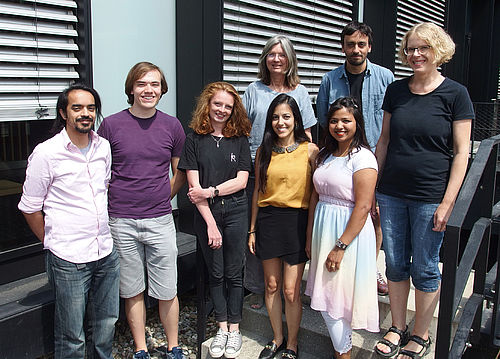
Professur für Neurophysiologie
|
|
|
|
This is our team in front of the “Natural Sciences West” building where
you can find us on the 2nd floor of building D4.
We are interested in sensory processing at the cellular and subcellular level, in particular in the first relay station of the mammalian olfactory system, the olfactory bulb. To observe single synapses at work we use electrophysiological techniques in combination with high-resolution neurophotonics (two-photon Ca2+ imaging, two-photon 2D and 3D uncaging of transmitter). We complement these experimental techniques with simulations to unravel the biophysical basis of reciprocal signaling, and more recently are also going systemic using a semi-intact nose-brain preparation.
The olfactory bulb neuronal network consists of a two-stage circuit, first the glomerular layer where processing is distributed within a high diversity of local interneurons, and second the external plexiform layer, where most processing takes place between the principal excitatory mitral cells and the inhibitory axonless granule cells. Both processing levels feature complex, often reciprocal synaptic interactions.
Our main current projects involve
- Function of granule cell reciprocal synapses. Our recent findings imply that the formation of an odor percept may be implemented already at the level of the olfactory bulb, by linking specifically co-active glomerular columns via granule-cell mediated lateral inhibition. This hypothesis could explain some up to now enigmatic features of both structure and physiology of reciprocal granule cell spine. We further investigate granule cell function in a DFG-project within our recently funded Research Unit 5424 „Modulation in olfaction“ (in collaboration with Andreas Schaefer, Crick Institute, London). We are also currently working on the structure of glomerular columns.
- Oscillatory network activity and odor coding in the olfactory bulb (DFG project, also within „Modulation in olfaction“, in collaboration with Markus Rothermel, Hannover). We have observed that this intrinsic system can be unlocked via activation of top-down cholinergic inputs during interaction with conspecifics and plan to investigate the cellular mechanism and its implications for social signalling in further detail.
- Function of the intrinsic vasopressin system of the olfactory bulb (Tandem grant with Silke Sachse, Jena within DFG Priority Program 2205 "Evolutionary optimisation of neuronal circuits"). Here we investigate possibly convergent evolution in flies and rodents with respect to anisotropic lateral inhibition between glomeruli.
- Function of long-range dopaminergic neurons in the glomerular layer Here we use our previously developed semi-intact nose-brain preparation to unravel the cellular mechanisms of oscillations within the bulb. Recently, we have discovered that arterial pressure pulsations such as those caused by heartbeat can excite mechanosensitive channels in mitral cells and entrain mitral cell spiking activity, also in vivo (in collaboration with Sebastian Bitzenhofer and Ileana Hanganu-Opatz, Hamburg). The function of this interoceptive modulation of olfactory bulb activity is entirely speculative at this point and might be related to arousal and attention.


